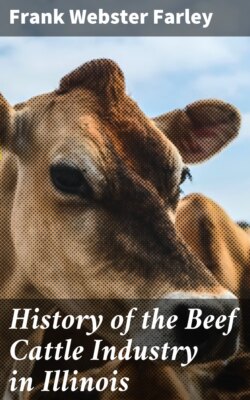Читать книгу History of the Beef Cattle Industry in Illinois - Frank Webster Farley - Страница 6
На сайте Литреса книга снята с продажи.
Cattle and Cattle Feeding[3]
ОглавлениеTable of Contents
When Illinois was first settled, almost the whole of the middle and the northern parts of the state were covered with a rank growth of native grasses, which furnished an ample supply and variety of forage of fair quality. "In the southern districts were heavy forests, but in the central and northern sections were but few groves or other timber growths to afford shelter to stock." The prairie grasses that grew in the central and northern districts were usually devastated by fire during the fall. However, the general fencing and cultivation of the land put a stop to the burning of these dead grasses of the prairies, and soon groves of oaks sprang up and covered many uncultivated spots. The leaves which stayed on these trees throughout the winter until spring, furnished valuable shelter to stock from the raw winter winds.
At the beginning of the settlement of Illinois, very little attention was given to the cattle interest. The pioneer settlers, however, had brought a few milk cows with them from the eastern states, but these cows were kept for milk only, no thought being given to beef production. After a few years, a few pure bred cattle were brought in, at which time some attention was given to beef, as well as to milk production, not for the beef produced, however, but principally to give a ready market for their grain crops.
The practice of raising beef cattle to market grain continued from then until near the end of the nineteenth century, when cattle feeding was no longer profitable as a grain market, and the question was: "How much beef can be produced from a bushel of corn?"[4]
"Despite the seemingly adverse character of the climate, Illinois has been, for some time, little, if any, behind other leading states of the Union in stock growing. In 1850, this state stood sixth in milk cows, and seventh in work oxen and other cattle. In 1860, it was tenth in work oxen, fifth in milk cows, and second in other cattle. In 1870, it was twenty-sixth in work oxen, fourth in milk cows, and second in the supply of other cattle. In 1880, it stood thirty-sixth in work oxen, second in milk cows, and third in other cattle. Iowa then had 240,280 and Texas had 1,812,860 more cattle than Illinois.
"The average value of milk cows in Illinois in 1884 was $35, and of oxen and other cattle, it was $28.04, while the average value of milk cows in Iowa was only $31.75, and of other cattle $26.00. The blood of the Shorthorns was used more largely than that of any other breed in the improvement of the cattle of the state. The first, and for some years, the only representatives of pure races of cattle in this state were Shorthorns, and to this date they exceed all other breeds in number."
The growth of the cattle interest in the State of Illinois, from 1850 to 1884, inclusive, is shown by the following statistics, taken from the United States Census Reports. The first figures of close accuracy on the number of cattle in the state were those gotten in 1850.
| Year | Milch Cows | Work Oxen | Other Cattle | Total | ||||
|---|---|---|---|---|---|---|---|---|
| No. | Inc. % | No. | Inc. % | No. | Inc. % | No. | Inc. % | |
| 1850 | 294,671 | 76,156 | 541,209 | 912,036 | ||||
| 1860 | 522,634 | 77.3 | 90,380 | 18.6 | 970,799 | 79.4 | 1,583,813 | 73.6 |
| 1870 | 640,321 | 22.5 | 19,766 | −78.1 | 1,055,499 | 8.7 | 1,715,586 | 8.3 |
| 1880 | 865,913 | 35.2 | 3,346 | −83.0 | 1,515,063 | 43.5 | 2,384,322 | 38.9 |
| 1883 | 716,102 | −17.3 | 1,253,765 | −17.2 | 1,969,867 | −17.4 | ||
| 1884 | 919,404 | 17.7 | 1,471,191 | 17.3 | 2,390,595 | 21.3 |
